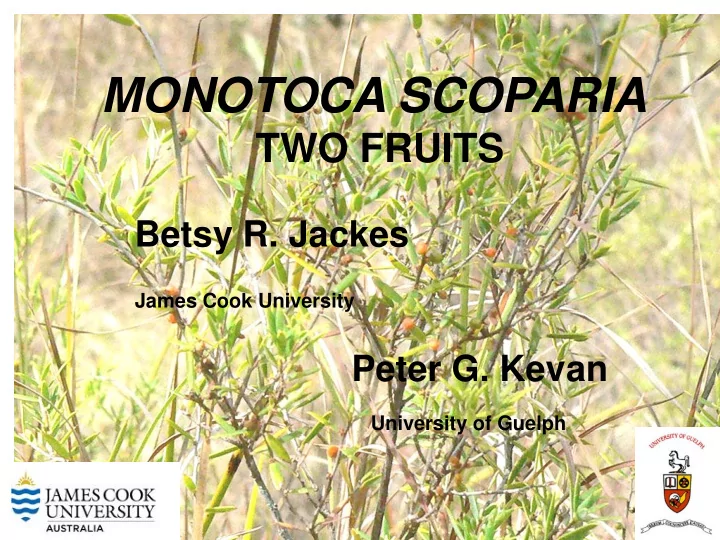

MONOTOCA SCOPARIA TWO FRUITS Betsy R. Jackes James Cook University Peter G. Kevan University of Guelph
MONOTOCA SCOPARIA • Subfamily Styphelioideae, family Ericaceae • Shrubs to 1.3 m tall, lignotuber present • Inflorescence axillary, few-flowered spikes often clustered • Functionally dioecious or ? • Ovary 1-locular • Fruit a drupe, yellow to orange
OBSERVATION ALL REPRODUCTIVE PLANTS NEAR PALUMA PRODUCED FRUITS. MAIN QUESTION IS MONOTOCA SCOPARIA GYNODIOECIOUS, FUNCTIONALLY DIOECIOUS OR?
Where are we? Wet Tropics bioregion Townsville Queensland BRISBANE
STUDY SITES • THREE POPULATIONS ALONG A DECREASING RAINFALL GRADIENT • QUADRAT 30 X 18 M • ALL PLANTS AT EACH SITE SEXED AND TAGGED AND CO-ORDINATES RECORDED • ARE SEXES RANDOMLY DISTRIBUTED OR NOT?
Site 1 19 o 00’ 27.8”S 146 o 05’ 31.3”E
Distribution Site 1
Site 2 19 o 00’ 08.1”S 146 o 04’ 48.7”E
Distribution Site 2
Site 3 18 o 59’ 59.5”S 146 o 04’ 29.5”E
FEMALE PLANTS (WITH STAMINODES) MALE PLANTS (WITH FERTILE STAMENS) WERE RANDOMLY DISTRIBUTED AT ALL SITES DESPITE VARIATIONS IN TOPOGRAPHY AND MOISTURE LEVELS
IS THERE A DIFFERENCE IN THE NUMBER OF FLOWERS PRODUCED PER SEX? For each sex, 10 plants tagged, 10 sprigs per plant tagged, each sprig 10 cm long, all flowers counted Female mean 1381, SD 196 Male mean 1295, SD 240 No significant difference
Female sprigs Male sprigs No significant difference
Female flower c. 1.5 mm long Male flower, c. 2.1 mm long ♀
DO MALE AND FEMALE PRODUCE EQUAL QUANTITIES OF NECTAR? Sprigs cut and placed in water, covered with a plastic bag, left overnight Then checked under a dissecting microscope and scored for the amount of nectar present.
1 = brim full 2 = well above ovary but not overtopping the style 3 = visible sparkle at base of corolla tube 4 = no visible nectar
NECTAR RESULTS Female n=150 Male, n= 192 1 (none visible) 56 0 2 49 2 3 32 72 4 (brim full) 13 96 Female flowers produced significantly more nectar than male flowers
POLLEN Pollen from 10 plants, 4 flowers per plant Stained with Alexander’s Stain – grains unstained or partially stained and irregular in shape recorded as aborted. Pollen grains per flower ranged from 2437 to 13375 mean 8762 % fertility or non-aborted grains = 81.9%
TWO FRUITS • Fruit from female plant firmly attached to parent globular to pear-shaped 2.4-2.7 mm long, 2.1-2.4 mm wide • Fruit from male plant weakly attached to parent cylindrical 2.5-3 mm long, 1.25-1.5 mm wide
Female plant
Female, mature and maturing
Male, mature and maturing
FRUIT SET • All fruit present on the tagged plants were collected after 2 months. • Percentage fruit set based on the number of buds and flowers recorded for each plant. • Combined data for sites 1 and 2 Female 27.11% Male 11.41%
‘male’ ‘female’
Presence or absence of a well-developed embryo • Fruits collected from both sites 1 and 2 • Method 1: Fruits cut in half and nature of the embryo noted microscopically, n=20 • Method 2: Fruits cleared with methyl salicylate (modified from Stelly et al. and Scriballo & Barrett). All questionable results confirmed by sectioning • Method 3: squishing
• Sex Site # examined #well-developed embryos female 1 154 87 2 296 142 450 229 male 1 327 0 2 216 0 (2 partial) 543 0 Note: No females without partially developed embryos
‘female’ seeds with endocarp 2.1-2.5 mm long, 1.2-1.5 mm wide
FLORAL VISITORS • 20 plants, 10 of each sex, 4 sweeps per plant • All insects captured and examined for pollen load • Only Trigona ?carbonaria carried Monotoca pollen. • Male plants, 21 bees captured • 10 with pollen, 11 lacking pollen • Female plants, 23 bees captured • 7 with pollen, 16 lacking pollen
CONCLUSIONS • Monotoca scoparia is functionally dioecious, sexes are randomly distributed • Two fruits develop but no viable embryos in ‘male’ fruit • Flowers differ in size and shape with sex • Female flowers produce considerably more nectar than male flowers • Trigona ? carbonaria is the pollinator
Recommend
More recommend